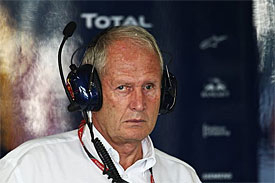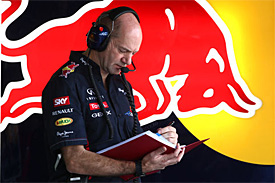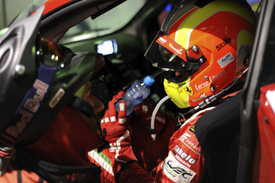| By Jonathan Noble | Thursday, January 31st 2013, 17:36 GMT |

McLaren may have raised some eyebrows with the step change in its car design for this season, but technical chiefs are adamant it was an essential move if it is to gun for Formula 1 title glory this year.
With the rules not changing dramatically for 2013, and teams already devoting much resource to the radical 2014 overhaul, it had been widely expected that the new cars would be mere evolutions of last year's designs.
McLaren has gone much further than that, however. It was reworked its concept in a wide range of areas, including switching to pull-rod suspension, increasing the height of its chassis so it now needs a 'vanity' panel' for a stepped nose, and being ultra-aggressive with the bodywork around the rear.
 Although such work may be a bold move with 2014 on the horizon, the team has said that such an effort was vital if the team was to be able to keep up a good enough development rate throughout the forthcoming campaign.
Although such work may be a bold move with 2014 on the horizon, the team has said that such an effort was vital if the team was to be able to keep up a good enough development rate throughout the forthcoming campaign.
When asked by AUTOSPORT about the thinking behind such an aggressive push with its car, McLaren engineering director Tim Goss said that there was a fear last year's MP4-27 concept was reaching a development ceiling.
"We looked at our performance during last season, in the stages where we were laying down the foundations of this car, and looked at where we thought we would get to in terms of our development rate if we just kept continuing with developing the same car," he said. "We realised we actually needed to make a larger step.
"So in defining the architecture of this car, the philosophy was very much to give ourselves the scope to further exploit the area of the cars that we knew would generate performance.
"We understand how to get the most out of these rules, and we demonstrated that last season under these rules with the quickest car at the beginning of the year and the end of the year.
"But, we decided that we need to give ourselves a bit more freedom and, as a result of that, we have reworked the car from front to back. That has allowed us that bit more freedom to push the areas of the car that we know respond."
Pull-rod front suspension
 One of the boldest departures for McLaren is in switching from a push-rod to pull-rod layout with its front suspension, a route that Ferrari went down last season.
One of the boldest departures for McLaren is in switching from a push-rod to pull-rod layout with its front suspension, a route that Ferrari went down last season.
Goss insisted that its change was not simply the result of it copying Ferrari's lead, but of doing a lot of work into evaluating the benefits and drawbacks of such a design.
"What convinced us was actually a lot of research," he said. "When you see something new on a car, you always think, why have they done that?
"In F1, it is possible to copy someone else's concept, but invariably they don't work. What you have to do is get a fundamental understanding of why.
"So we looked at it and initially we thought exactly that - why? But after some time and some work we understood how it could benefit our car and certainly what we are trying to achieve with the car.
"We found benefits in terms of aerodynamics, which overcome the kinematic and structural negatives of doing more extreme anhedral suspension."
Exhaust concept
 One area where McLaren has stuck to its guns, however, is in its exhaust concept, which is a different solution to the Red Bull style.
One area where McLaren has stuck to its guns, however, is in its exhaust concept, which is a different solution to the Red Bull style.
This year, McLaren has pushed things much further, dramatically cutting away the bodywork at the rear of the car to try and optimise airflow for both car performance and exhausts.
"It is playing the tunes on the aerodynamics," said Goss. "While trying to achieve one thing with the exhaust, you have to make sure when the exhaust gases are not flowing that the rear end of the car is still performing properly.
"So we have pushed things further. That is our philosophy on this car - to take the things where we know the car responds, push them further and make them more extreme. For us, it was a natural evolution of last year."
McLaren MP4-28 - full coverage:
 McLaren unveils new MP4-28 F1 car
McLaren unveils new MP4-28 F1 car
 Lowe staying for 2013, McLaren insists
Lowe staying for 2013, McLaren insists
 MP4-28 unveiling gallery
MP4-28 unveiling gallery
 Perez hails 2013 preparations
Perez hails 2013 preparations
 McLaren won't race passive double DRS
McLaren won't race passive double DRS

 Red Bull Racing boss Christian Horner insists that Helmut Marko's recent criticisms of Mark Webber should not be taken as a sign that the Formula 1 team itself has any doubts about the Australian's talent.
Red Bull Racing boss Christian Horner insists that Helmut Marko's recent criticisms of Mark Webber should not be taken as a sign that the Formula 1 team itself has any doubts about the Australian's talent. Red Bull technical chief Adrian Newey is open to the Formula 1 champion team using a passive DRS-style device during the 2013 season, but admitted it was tough to make such a system effective.
Red Bull technical chief Adrian Newey is open to the Formula 1 champion team using a passive DRS-style device during the 2013 season, but admitted it was tough to make such a system effective. You couldn't say that Red Bull technical genius Adrian Newey resented being at the launch of RB9 - his demeanour was plenty breezy enough - but he did seem somewhat bemused at the whole concept of a pre-season unveiling.
You couldn't say that Red Bull technical genius Adrian Newey resented being at the launch of RB9 - his demeanour was plenty breezy enough - but he did seem somewhat bemused at the whole concept of a pre-season unveiling. You could squint at the RB9 from a distance, but the covers were swiftly pulled back across as the press conference drew to a close. And Red Bull bucked the trend for online launch broadcasts too.
You could squint at the RB9 from a distance, but the covers were swiftly pulled back across as the press conference drew to a close. And Red Bull bucked the trend for online launch broadcasts too. Former World Rally champion Marcus Gronholm will make his return to a WRC car after his 2012 injury on Monday when he tries Motorsport Italia's Mini.
Former World Rally champion Marcus Gronholm will make his return to a WRC car after his 2012 injury on Monday when he tries Motorsport Italia's Mini. Mikko Hirvonen is confident he can get his 2013 World Rally title challenge underway properly by winning Rally Sweden next week.
Mikko Hirvonen is confident he can get his 2013 World Rally title challenge underway properly by winning Rally Sweden next week. "Obviously, we'll have to deal with the conditions, which can vary depending on how cold it gets and any snowfall. That can affect the wear of the tyres.
"Obviously, we'll have to deal with the conditions, which can vary depending on how cold it gets and any snowfall. That can affect the wear of the tyres. Jari Ketomaa moved ahead of Craig Breen in their battle for the Rally Liepaja-Ventspils lead on day two in Latvia.
Jari Ketomaa moved ahead of Craig Breen in their battle for the Rally Liepaja-Ventspils lead on day two in Latvia. Craig Breen leads Rally Liepaja-Ventspils after the opening afternoon of round two of the European Rally Championship in Latvia.
Craig Breen leads Rally Liepaja-Ventspils after the opening afternoon of round two of the European Rally Championship in Latvia. Force India has admitted that it had planned to run Jules Bianchi as its reserve driver for two years before considering him for a Formula 1 race drive.
Force India has admitted that it had planned to run Jules Bianchi as its reserve driver for two years before considering him for a Formula 1 race drive. "Paul will be the key focus for Jerez. After that, the shareholders will be ready I think to announce the three-driver line-up, which will see us into 2013 and hopefully longer term."
"Paul will be the key focus for Jerez. After that, the shareholders will be ready I think to announce the three-driver line-up, which will see us into 2013 and hopefully longer term." Chris Atkinson will rejoin the Citroen fold for round three of the 2013 World Rally Championship in Mexico next month.
Chris Atkinson will rejoin the Citroen fold for round three of the 2013 World Rally Championship in Mexico next month. Marussia has become the final Formula 1 team to announce its 2013 launch date, as it confirmed the covers will come off the MR02 on the morning of the opening test day.
Marussia has become the final Formula 1 team to announce its 2013 launch date, as it confirmed the covers will come off the MR02 on the morning of the opening test day.
 Although such work may be a bold move with 2014 on the horizon, the team has said that such an effort was vital if the team was to be able to keep up a good enough development rate throughout the forthcoming campaign.
Although such work may be a bold move with 2014 on the horizon, the team has said that such an effort was vital if the team was to be able to keep up a good enough development rate throughout the forthcoming campaign. One of the boldest departures for McLaren is in switching from a push-rod to pull-rod layout with its front suspension, a route that Ferrari went down last season.
One of the boldest departures for McLaren is in switching from a push-rod to pull-rod layout with its front suspension, a route that Ferrari went down last season. One area where McLaren has stuck to its guns, however, is in its exhaust concept, which is a different solution to the Red Bull style.
One area where McLaren has stuck to its guns, however, is in its exhaust concept, which is a different solution to the Red Bull style. Five-time American Le Mans Series champion Olivier Beretta will return to the series with the Risi Competizione Ferrari team in 2013.
Five-time American Le Mans Series champion Olivier Beretta will return to the series with the Risi Competizione Ferrari team in 2013.